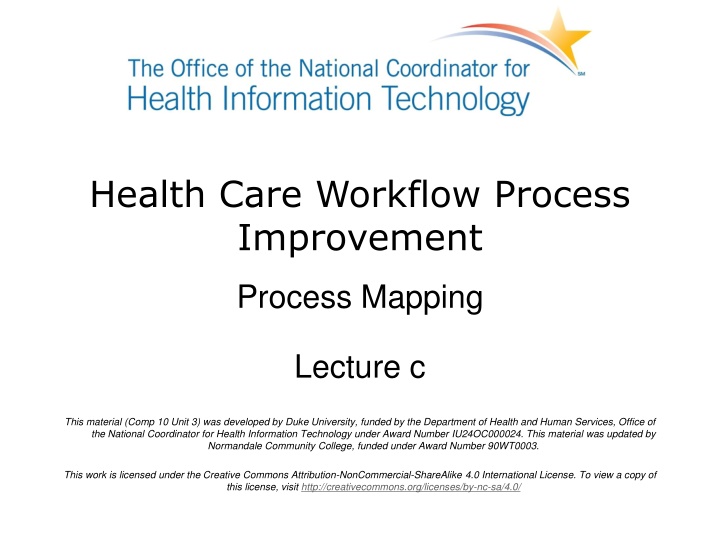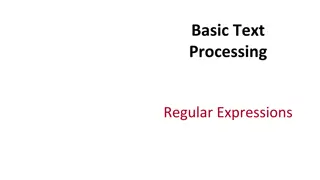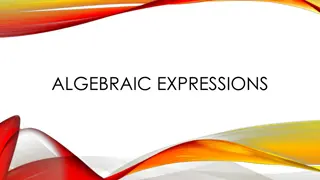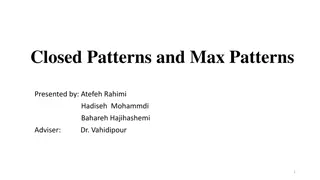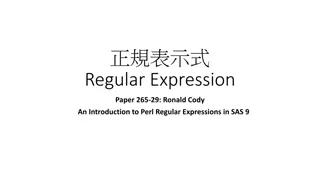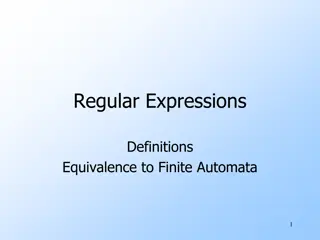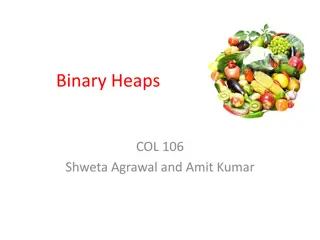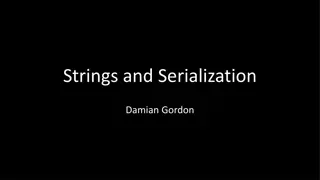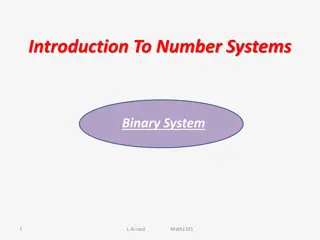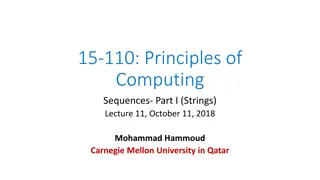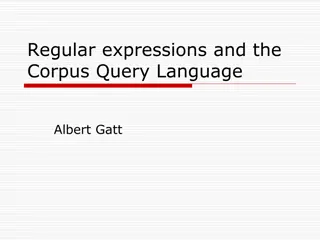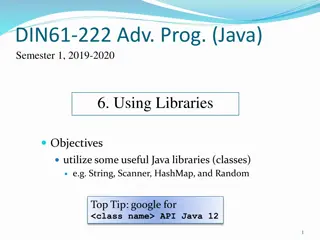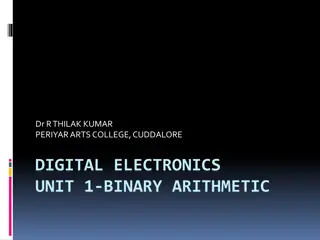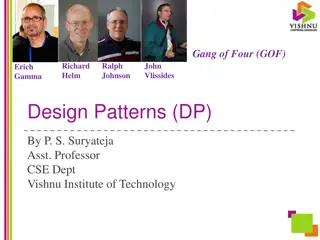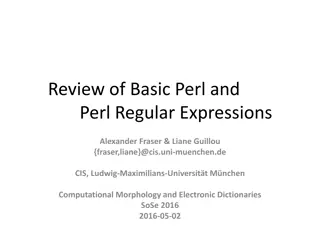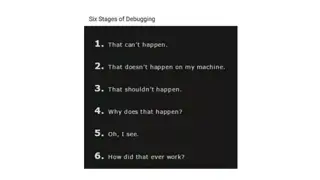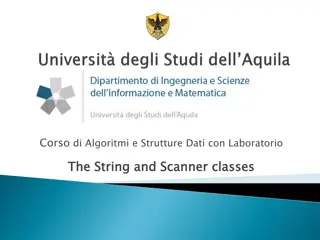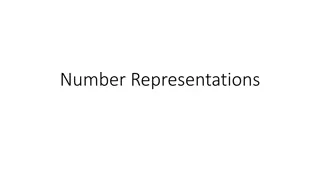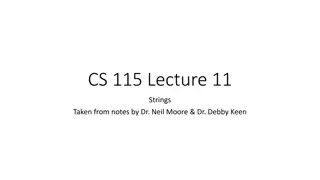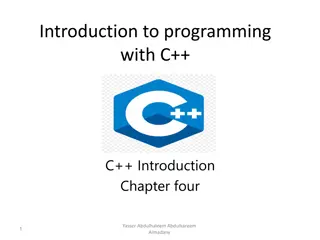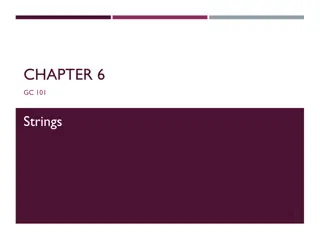Regular Expressions: Binary String Patterns
Regular expressions are powerful tools for defining patterns in strings. Explore various examples of regular expressions for binary strings, including those congruent to 1 mod 4, odd-length strings, limited ones, and more. Practice creating regex patterns for different scenarios and gain practical advice for effective usage in programming tasks.
Download Presentation

Please find below an Image/Link to download the presentation.
The content on the website is provided AS IS for your information and personal use only. It may not be sold, licensed, or shared on other websites without obtaining consent from the author.If you encounter any issues during the download, it is possible that the publisher has removed the file from their server.
You are allowed to download the files provided on this website for personal or commercial use, subject to the condition that they are used lawfully. All files are the property of their respective owners.
The content on the website is provided AS IS for your information and personal use only. It may not be sold, licensed, or shared on other websites without obtaining consent from the author.
E N D
Presentation Transcript
Health Care Workflow Process Improvement Process Mapping Lecture c This material (Comp 10 Unit 3) was developed by Duke University, funded by the Department of Health and Human Services, Office of the National Coordinator for Health Information Technology under Award Number IU24OC000024. This material was updated by Normandale Community College, funded under Award Number 90WT0003. This work is licensed under the Creative Commons Attribution-NonCommercial-ShareAlike 4.0 International License. To view a copy of this license, visit http://creativecommons.org/licenses/by-nc-sa/4.0/
Process Mapping Learning Objectives Create context and data flow diagrams for a health care system (or system component) using appropriate Yourdon symbols and conventions Choose the correct scope and detail level for a process flowchart and data flow diagram 2
Process Mapping Lecture c - Topics Yourdon data flow diagram symbols and conventions Creating data flow diagrams (DFDs) for a given a health care scenario 3
Background Data flow diagrams (DFDs) provide a way to document and visualize the movement of data through a process Yourdon notation was introduced in Edward Yourdon s 1989 book Modern Structured Analysis Yourdon notation exists for three types of diagrams : Data flow diagrams State transition diagrams Entity-relationship diagrams The most commonly used in health care is the data flow diagram covered in this lecture 4
Methods for Diagramming Processes E-R ISO 5807 Yourdon data flow Gane- Sarson UML Process Aspects diagram Context X X Process steps Data flow steps Information content Data transformation Flow control and state Roles involved X X X X X X X X X X X text X text X X text X X X X Table 3.3 Methods for Diagramming Processes. Nahm, M, 2012. 5
Use The most popular use of Yourdon notation is to depict the context in which a process operates, i.e., high level interactions among o Major entities o Interactions between the process and outside entities. Context and more detailed DFDs show Entities Processes (the data transformation part) Data stores Rather than procedural details 6
Context Diagram Example This is an example of the Context Diagram 7
Yourdon Symbols Dataflow diagrams consist of processes, data stores, entities, and flows These symbols are Yourdon Symbols 9
Entities Entity Represent people, organizations, or other things that interact with an information processing system Computerized or manual Named with a noun or noun phrase Send or consume information Data flows can come to and from entities only from processes 10
Process Process Named with a single word, phrase, or simple sentence that describes what the process does: A good name consists of a verb-object phrase o Such as assessment or assess patient Alternatively, a name may be a person, group of people, computer, or mechanical device It must have both inputs and outputs 11
Flow Flow Represented by curved arrows Arrow heads on the flow indicate direction Name represents the meaning of the data that moves along the flow The same content may have a different meaning in different parts of the system 12
Data Store Data store Represents a collection of data at rest Named with noun or noun phrase Can be computerized or non-computerized, such as paper charts Data stores are passive Arrows to data stores mean write, update, delete Arrows from data stores mean read, retrieve, use Data flows to data stores can NOT come from other data stores or from entities 13
Event List In Yourdon notation, an event list accompanies a data flow diagram An event list contains things that stimulate action from the system For example, for prescribing: A patient calls for a re-fill A pharmacy calls for a re-fill A patient presents with a problem requiring medication 14
Conventions Choose meaningful names for processes, flows, stores, and terminators Number the processes by placing a unique number in the circle at the top Redraw the DFD as many times as necessary until it is clear and complete Simplify DFDs A good DFD fits on one page and is not too crowded. If additional details are needed, processes can be exploded on a new page Everything on one page should be at the same detail level 15
Matters of Style Size and shape of bubbles are up to the diagram creator and their client Curved or straight arrows can be used. Looks neater with one or the other but not both There is no excuse for hand-drawn diagrams today except during a white-boarding stage Some name the processes for the role that they perform Some use color to differentiate types of entities or flows 16
Beware of Black holes Processes that have inputs but no outputs Miracles Processes that have outputs but no inputs Mysteries Unlabeled flows and unlabeled processes 17
Leveled Diagrams Are encouraged Start with higher level (context) diagrams to understand the scope and boundaries Decompose processes to lower levels of detail when needed Remember the ultimate goal is an optimized clinic process not a large detailed set of diagrams 18
Guidance from Yourdon even if our job were to design the world, we would have to recognize that the world is only a part of the solar system, which is part of a small, obscure galaxy, which is (ultimately) part of the universe. the first major model that you must develop as a systems analyst is one that does nothing more than define the interfaces between the system and the rest of the universe, that is, the environment. -Yourdon, Just Enough Structured Analysis 19
There have been variations on Yourdon notation Yourdon-Code Yourdon-DeMarco Yourdon concepts and notation have been adapted to suit needs of individual projects Yourdon notation for data flow diagrams has been adapted for health care process analysis and redesign by the Pubic Health Informatics Institute (PHII) in their recent Common Ground Initiative Agency for Healthcare Research and Quality (AHRQ) funded initiatives Yourdon himself makes the point that the actual shape chosen is not important as long as the analyst uses the shape to consistently represent the same meaning 20
Example of a Modified Yourdon DFD Modifications: Uses one shape and does not distinguish between process, entity and data store Calls it a context diagram Differentiates types of flows Reprinted from Cabarrus Health Alliance http://www.cabarrushealth.org/ 21
Context Diagram Example Without looking at the next slide, draw a one- page DFD for a prescription refill process at a primary care provider based on the following scenario: Mrs. Jones takes Benecar 20mg QD for blood pressure control. She has taken this medicine for two years with good results. She does not use the auto refill program at her local pharmacy. Today, she called her provider, who does not use e-prescribing, and asked if the prescription could be called in to her pharmacy. 22
Maintenance Yourdon notation is a set of symbols and conventions named for the person who developed it, Edward Yourdon Yourdon notation has not been adopted as a standard There is no formal maintenance organization Individuals use and adapt it to suit their needs For an adaptation to still be a context diagram, it must show entities, processes and interactions 24
Process Mapping Summary Lecture c Explain two ways process diagrams are used as models Distinguish the physical steps from information flow in a health care process involving an EHR Choose an appropriate process diagram to model given aspects of a process 25
Process Mapping References Lecture c References Yourdon, E. (2006). Just Enough Structured Analysis (Rev ed.). Retrieved from Yourdon Website Charts, Tables, and Figures 3.3 Table. Nahm, M, Methods for diagramming processes, 2012. Images Slide 7: Context Diagram Example. Nahm ,M., Duke University, 2012. Slide 8: Example DFD for Patient visit. Nahm, M. Duke University, 2012. Slide 9: Yourdon Symbols or dataflow diagrams. Nahm ,M., Duke University, 2012. Slide 10: The "Entity" symbol in Yourdon notation. Nahm ,M., Duke University, 2012. Slide 11: The "Process" symbol in Yourdon notation. Nahm, M., Duke University, 2012. Slide 12: The "Flow" symbol in Yourdon notation. Nahm M., Duke University, 2012. Slide 13: "Data Store" symbol utilization in Yourdon notation. Nahm, M., Duke University, 2012. Slide 21: Diagram showing relationships of software processes in public health departments. Cabarrus Health Alliance. http://www.cabarrushealth.org/ Slide 23: Example prescription refill context diagram. Nahm, M., Duke University, 2012. 26
Process Diagrams Lecture c This material was developed by Duke University, funded by the Department of Health and Human Services, Office of the National Coordinator for Health Information Technology under Award Number IU24OC000024. This material was updated by Normandale Community College, funded under Award Number 90WT0003. 27
